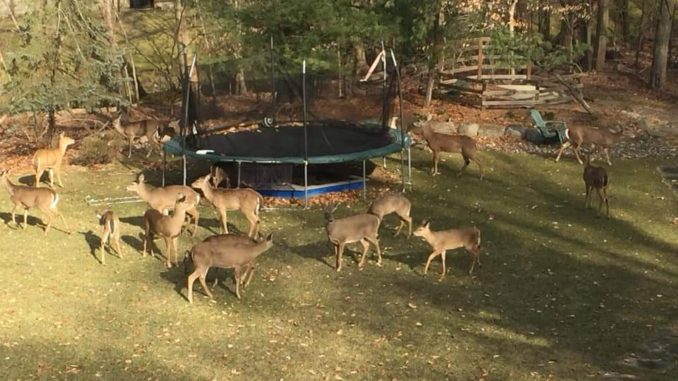
RIVER VALE, N.J.—At least for 2019, the deer in River Vale are safe.
Mayor Glen Jasionowski told residents Sept. 9 that as the state has not met yet with local officials on the issue there won’t be a bowhunt this year to thin local herds. The prospect of a hunt has roiled council meetings and drawn protests from animal-protection groups.
Jasionowski also said he was awaiting more information from Police Chief Sean Scheidle before making a final decision on whether to proceed.
The mayor said the chief was reviewing data and information on safety issues related to a bowhunt.
He also said an ordinance would need to be passed before a bowhunt could be held—and that could not occur this year.
Jasionowski later said a decision on a 2020 deer bowhunt was likely by late September or early October.
He said he would make his view known after hearing from Scheidle, and then he’d make his recommendation to the council, which will then deliberate.
Since Jasionowski raised the prospect of a deer hunt last October, the issue has dominated on local social media and at public meetings, where passions have run high on all sides.
In late August, Jasionowski told Pascack Press that he would have an announcement on a proposed bowhunt at the council’s first September meeting. He later said he was hoping to make a decision on whether to proceed with a bowhunt.
“If we didn’t meet with the state already, it’s not happening this year,” Jasionowski said on social media. “I respect everyone’s opinion; please stop spreading the false information,” he urged.
“We’re always honest and up front whether you like what we have to say or not and I ask everybody else try and do the same thing. Thank you,” he said.
Following a protest Sept. 9 by advocates from Animal Protection League of New Jersey, Jasionowski thanked them for their peaceful protest in downtown River Vale and for “not spreading false information” online.
He urged commenters engage in civil and respectful commentary.
In their own words
Resident Ralph Napoli said he favored a controlled deer hunt due to the “explosion of the deer population.”
He said 30 years ago folks in town enjoyed the deer. Six months ago, he said, he struck a deer on the road and racked up $13,000 in repairs.
He said over the past decade his garden has been decimated “year after year,” and a neighbor came down with Lyme disease, which is spread by deer ticks. He warned about the township’s increasing deer numbers.
“Where does this end?” he said.
Shannon Farley of Coopers Lane said she felt it was “completely inappropriate” for council to allow a hunt that she asserted would hurt property values.
“I would not choose to move to a town that does an annual slaughter and many others will feel the same way,” she said.
Farley suggested deer damage be addressed by residents purchasing deer-proof fences and repellent sprays and public safety concerns be addressed by signage and ticketing teenagers who speed on side streets.
“Don’t blame the deer because we’re cutting down their woods,” she said. She questioned the recent drone census showing 96 deer per square mile.
The census was conducted by wildlife researchers from Raritan Valley Community College. Biologists say about 10 deer per square mile are the most that can be supported within a square mile.
Councilman Ari Ben-Yishay asked Farley for her data showing impacts on property values from a deer hunt. Farley said she could not produce any but maintained as a certified public accountant and finance person that such harm would result.
Patty Kilbride, of Westwood, said she had 225 signatures, most of them from River Vale, on a petition opposing a deer hunt. She said she wondered why a deer hunt decision was not put to public referendum as Jasionowski had previously floated.
Resident Peter Jacobsen said he believed a bowhunt was necessary. He praised the council’s work.
He said deer come through his yard every day and that he’s spent “thousands and thousands” of dollars to maintain his property as a result. He said over his 65 years in town “it’s never been this bad.”
Al Villavecchia, a resident of more than 30 years, said community safety and deer herd health need to be addressed and suggested culling or relocating the deer.
“If we close our eyes and do nothing because we love animals it’s all well and good but we’re not doing anything to address the problem,” he said.
Emerson resident Maria Buchert said during a recent deer hunt protest in Saddle River a resident showed her a garden with deer-resistant plants.
She suggested such plants and urged non-lethal methods be used “and not violence to handle the issue.”
Woodcliff Lake resident Mark Flannigan, a former resident, said he observed the number of deer near his property, which borders Saddle River, as “rapidly approaching” the numbers prior to Saddle River’s 2018–2019 bowhunt.
Officials said the hunt culled 135 deer. He urged River Vale officials be aware of “the ultimate futility, unless you’re OK with an annual slaughter.”
Following the meeting, Jasionowski spoke with residents and animal-protection advocates outside town hall for another half-hour to discuss aspects of a possible future deer hunt, differing points of view, the local anti-hunt protests, and inaccurate and false social media posts.
He said any valid data that’s provided would be considered along with—most importantly—professional opinions of local police officials on whether a hunt can be safely conducted.
He said going through the deer bowhunt decision process has become more complicated as more data becomes available as the process continues.
Jasionowski told the activists that had surgical sterilization been an approved option by state officials, he said that would have been his first choice had that option been available.
